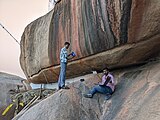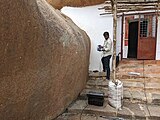
Shravanabelagola is a town located near Channarayapatna of Hassan district in the Indian state of Karnataka and is 144 km (89 mi) from Bengaluru. The Gommateshwara Bahubali statue at Shravanabelagola is one of the most important tirthas in Jainism, one that reached a peak in architectural and sculptural activity under the patronage of Western Ganga dynasty of Talakad. Chandragupta Maurya is said to have died on the hill of Chandragiri, which is located in Shravanabelagola, in 298 BCE after he became a Jain monk and assumed an ascetic life style.

Magadi is a town and taluk located in Bengaluru South district, Karnataka, India.
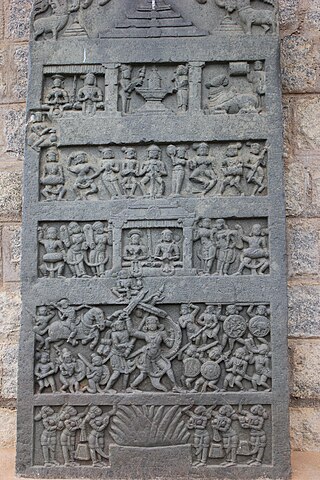
A hero stone is a memorial commemorating the honorable death of a hero in battle. Erected between the second half of the first millennium BCE and the 18th century CE, hero stones are found all over India. They often carry inscriptions and a variety of ornaments, including bas relief panels, frieze, and figures in carved stone. Usually they are in the form of a stone monument and may have an inscription at the bottom with a narrative of the battle. The earliest and oldest of such memorial hero stones is found in the Indian state of Tamil Nadu is more than 2400 years old that is 4th century BCE. According to the historian Upinder Singh, the largest concentration of such memorial stones is found in the Indian state of Karnataka. About two thousand six hundred and fifty hero stones, the earliest in Karnataka is dated to the 5th century CE. The custom of erecting memorial stones dates back to the Iron Age though a vast majority were erected between the 4th century BCE to 13th centuries CE.

The Siddhesvara Temple is located in Haveri in Haveri district, Karnataka state, India. It is considered an ornate example of 12th-century Western Chalukyan art and is well known for the many loose sculptures of Hindu deities that exist in it. However, inscriptional evidence would suggest that the initial consecration of the temple was in the late 11th century. An exciting aspect of the temple is that it faces west instead of facing the rising sun in the east–a standard in Chalukyan constructions. Though it is currently used as a Shaiva temple dedicated to God Shiva, historians are unsure by which faith or sect the temple was consecrated initially and to which deity. Many people visit the temple for their spiritual beliefs, while evidence about temple visits can be found in Gita chapter 17, verse 23, which says otherwise. Most of the Lord Shiva sculptures are observed to be of him meditating. There are claims that he meditates on himself, whereas some proof can be found in Devi-Bhagavata Purana that Lord Shiva meditates for some other God. This uncertainty perhaps stems from the many loose sculptures of deities and the degradation of primary wall images.
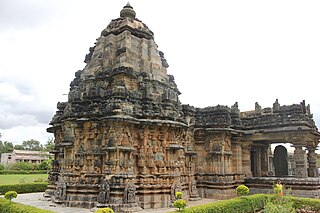
The Kalleshwara temple is located in the town of Hire Hadagali of the Hoovina Hadagalitaluk in Bellary district of Karnataka state, India.

The Kalleshvara temple is located in the town of Ambali in Bellary district of Karnataka state, India. According to an Old Kannada inscription placed in the sabhamantapa, the temple was constructed during the reign of the Western Chalukya Empire King Vikramaditya VI. This temple is protected as a monument of national importance by the Archaeological Survey of India.
Gulakamale is a village in Bangalore district, Karnataka, India, near Kaggalipura on Bangalore – Kanakapura Road. The population of the village is 2,293 which made up of 1,131 males and 1,162 females. The literacy rate is lower than that of Karnataka and stands at 71.82% as opposed to 75.36% of the rest of the state. Out of those who are literate are 81.05% male and 62.70% female populations. Scheduled Castes and Tribes make up 51.72% and 0.22% respectively.

Veeranarayana Temple in Gadag city is a Hindu temple known to have been built around c.1117 by the Hoysala empire King Vishnuvardhana. Gadag city is the administrative headquarters of Gadag district in the state of Karnataka, India. The primary deity in temple is the Hindu god Narayana. The Veeranarayana temple is a protected monument under the Karnataka state division of the Archaeological Survey of India. Priests in the temple are Madhva Brahmins and is under their control.

Gulakamale is located in Bangalore South taluk of Bangalore district in Karnataka, India. Two inscriptions are found in Gulakamale of which one is a donation inscription, and the other, a Mahasati herostone, a typology of herostones dedicated to women who self-sacrificed in sati. Additionally, two other hero stones are also found at the same place.Gulakamale is also famous for its lake, a birding hotspot on the city's outskirts.
Ivara Kandapura is a small hamlet adjoining Hesaraghatta on the northern outskirts of Bangalore, in Karnataka, India. Ivara Kandapura is famous for a 10th-century temple complex that is home to five temples, named after the pandavas as The Dharmeshwara, Nakuleshwara, Bheemeshwara, Sahadeshwara, Arjuneshwara and Kunti Gudi.

Domlur is a locality in the eastern part of Bengaluru city in India. Domlur is a historic places as indicated in the 18 inscriptions spanning the period 1200-1440CE found there. Of these, 16 inscriptions are at the Chokkanathaswamy Temple dedicated to the deity Chokkanathaswamy or the Chokka Perumal [the Hindu God Vishnu]. Of these eleven inscriptions are from the period 1200-1440 CE and have been documented earlier in Epigraphia Carnatica, Vol 9, these are mostly donatory inscriptions for the deity Chokkanathaswamy and for the Someshwara temple (non-existent).

Singapura is a locality in the northwestern part of Bengaluru, Karnataka, India. The Varadarajaswamy Temple in Singapura is at least 500 years old, as recorded in Harohalli and Chikkabettahalli inscriptions. The temple is referred to as the Tiruvengalanatha temple in inscriptions. The inscriptions also mention a grant given to Ramanuja Koota, a religious institution of Sri Vaishnavites, named after the reformer-saint Ramanuja.

Jakkur, a suburb in Bengaluru is an old locality that has an historicity of about 700 years. The locality is home to four inscriptions and several hero stones. The earliest inscriptions of the area can be paleographically dated to 9th - 10th century CE. These inscriptions also indicate that Jakkur Lake, regarded as one of the biggest lakes of Bangalore, existed as old as seven centuries ago.
Chikkabanavara is a residential locality in north Bengaluru, Karnataka, India. Chikkabanavara is also an ancient locality as evidenced by six inscriptions that have been discovered there. Additionally an ancient Kalyani and a few old temples allude to the historicity of the locality. Chikkabanavara is also home to one of the Bengaluru's ancient lakes, its documented history traced to at least a thousand years based on inscriptional references. Additionally, other ancient artefacts such as, Nagastones, fragmented pillars, memorial stones are also found at Chikkabanavara.
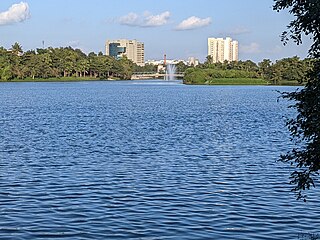
Allalasandra is a historic locality in North Bengaluru adjoining the Gandhi Krishi Vigyan Kendra (GKVK) campus on Bellary road. Allasandra's historicity tracing back to about 500 years can be attested from the Rachur Narasappiah's Donation Inscription mentions the donation of the entire village of Allalasandra to the Allalanatha temple at Jakkur.
Bileshivale is a historic locality in Bengaluru. An inscription at Bileshivale is being documented here for the first time. It documents existence of a temple in the 14th century at Bileshivale, the location of which cannot be ascertained. This inscription shows that Kalkere, the lake and the place are at least 700 years old.

It is a Kannada inscription paleographically dated to the 15th century CE, discovered by the Mythic Society Bengaluru Inscriptions 3D Digital Conservation Project team in April 2022 in the Anjaneya Temple,Anjanapura. Much information cannot be contextualized as the text is effaced but appears to be a donatory inscription. The typical character size of the Inscription is 4.9 cm tall, 7.1 cm wide and 0.15 cm deep.
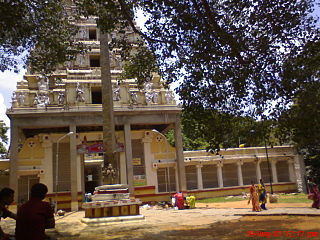
The Basavanagudi Inscriptions are a set of three Kannada and one Tamil inscriptions that can be found in the locality of Basavanagudi. Of the four, three Kannada inscriptions are physically present and the fourth Tamil inscription's physical status remains unknown. The available Kannada inscriptions can be found in Bugle rock park and Dodda Basavana Gudi or Big bull temple. Two inscriptions found in the vicinity of Dodda Basavana Gudi or Big bull temple, both describe the Vrishabhavati river's origin as coming from the feet of the Basava idol in the temple's sanctum and flowing westwards thereon as Paschimavahini. The two inscriptions can be found: one on the pedestal of the Basava deity in the sanctum and the other on a boulder in the shrubbery surrounding the temple. Two more inscriptions that are published, one is a one line Tamil inscription in Grantha script published in Epigraphia Carnatica and is about possible donatory inscription to the Chokkanathaswamy Temple in Domlur, a locality in Bengaluru, its physical status is not known at present and the other is a one line Kannada inscription in the Kannada script published in Itihasa Darshana Journal and is present on a boulder in the Bugle rock park in Basavanagudi is about one Deevatige Soma.
Marasuru Madivala is a village in Anekal Taluk of Bengaluru, in the Indian state of Karnataka. It is a historical settlement with a history of over a millennium, its significance lies in the discovery of an herostone-inscription and an ornate sculpture of Chamundi found in the village which is currently housed in a new mantapa. It is home to a 10th-century Someshwara temple, and a modern-day Nandi mantapa restored with 8th-century Ganga style stone pillars, Sati stones, hero-stones and a few ancient Jaina idols.






